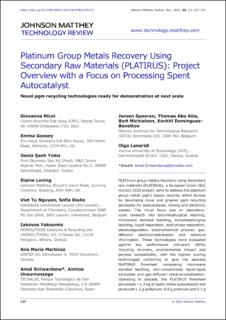| dc.contributor.author | Nicol, Giovanna | |
| dc.contributor.author | Goosey, Emma | |
| dc.contributor.author | Yildiz, Deniz Sanli | |
| dc.contributor.author | Loving, Elaine | |
| dc.contributor.author | Nguyen, Viet Tu | |
| dc.contributor.author | Riaño, Sofía | |
| dc.contributor.author | Yakoumis, Iakovos | |
| dc.contributor.author | Martinez, Ana Maria Cuellar | |
| dc.contributor.author | Siriwardana, Amal | |
| dc.contributor.author | Unzurrunzaga, Ainhoa | |
| dc.contributor.author | Spooren, Jeroen | |
| dc.contributor.author | Atia, Thomas Abo | |
| dc.contributor.author | Michielsen, Bart | |
| dc.contributor.author | Dominguez-Benetton, Xochitl | |
| dc.contributor.author | Lanaridi, Olga | |
| dc.date.accessioned | 2022-08-05T12:17:56Z | |
| dc.date.available | 2022-08-05T12:17:56Z | |
| dc.date.created | 2022-02-23T19:20:54Z | |
| dc.date.issued | 2021 | |
| dc.identifier.citation | Johnson Matthey Technology Review. 2021, 65 (1), 127-147. | en_US |
| dc.identifier.issn | 2056-5135 | |
| dc.identifier.uri | https://hdl.handle.net/11250/3010367 | |
| dc.description.abstract | PLATInum group metals Recovery Using Secondary raw materials (PLATIRUS), a European Union (EU) Horizon 2020 project, aims to address the platinum group metal (pgm) supply security within Europe by developing novel and greener pgm recycling processes for autocatalysts, mining and electronic wastes. The initial focus was on laboratory-scale research into ionometallurgical leaching, microwave assisted leaching, solvometallurgical leaching, liquid separation, solid phase separation, electrodeposition, electrochemical process: gas-diffusion electrocrystallisation and selective chlorination. These technologies were evaluated against key performance indicators (KPIs) including recovery, environmental impact and process compatibility; with the highest scoring technologies combining to give the selected PLATIRUS flowsheet comprising microwave assisted leaching, non-conventional liquid-liquid extraction and gas-diffusion electrocrystallisation. Operating in cascade, the PLATIRUS flowsheet processed ~1.3 kg of spent milled autocatalyst and produced 1.2 g palladium, 0.8 g platinum and 0.1 g rhodium in nitrate form with a 92‐99% purity. The overall recoveries from feedstock to product were calculated as 46 ± 10%, 32 ± 8% and 27 ± 3% for palladium, platinum and rhodium respectively. The recycled pgm has been manufactured into autocatalysts for validation by end users. This paper aims to be a project overview, an in‐depth technical analysis into each technology is not included. It summarises the most promising technologies explored, the technology evaluation, operation of the selected technologies in cascade, the planned recycled pgm end user validation and the next steps required to ready the technologies for implementation and to further validate their potential. | en_US |
| dc.language.iso | eng | en_US |
| dc.publisher | Johnson Matthey | en_US |
| dc.rights | Attribution-NonCommercial-NoDerivatives 4.0 Internasjonal | * |
| dc.rights.uri | http://creativecommons.org/licenses/by-nc-nd/4.0/deed.no | * |
| dc.title | Platinum group metals recovery using secondary raw materials (platirus): Project overview with a focus on processing spent autocatalyst | en_US |
| dc.type | Peer reviewed | en_US |
| dc.type | Journal article | en_US |
| dc.description.version | publishedVersion | en_US |
| dc.rights.holder | © 2021 Johnson Matthey | en_US |
| dc.source.pagenumber | 127-147 | en_US |
| dc.source.volume | 65 | en_US |
| dc.source.journal | Johnson Matthey Technology Review | en_US |
| dc.source.issue | 1 | en_US |
| dc.identifier.doi | 10.1595/205651321x16057842276133 | |
| dc.identifier.cristin | 2004974 | |
| cristin.ispublished | true | |
| cristin.fulltext | original | |
| cristin.qualitycode | 1 | |

